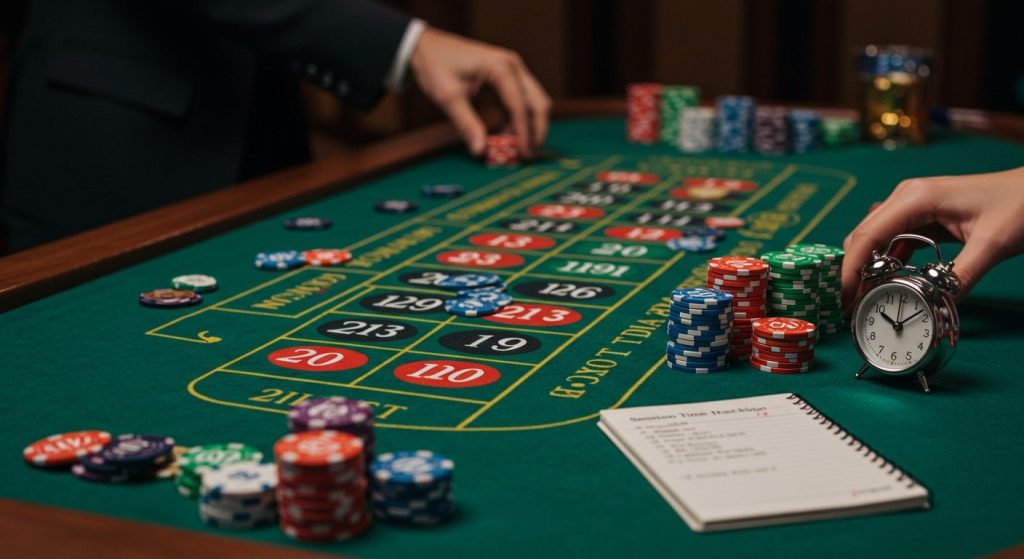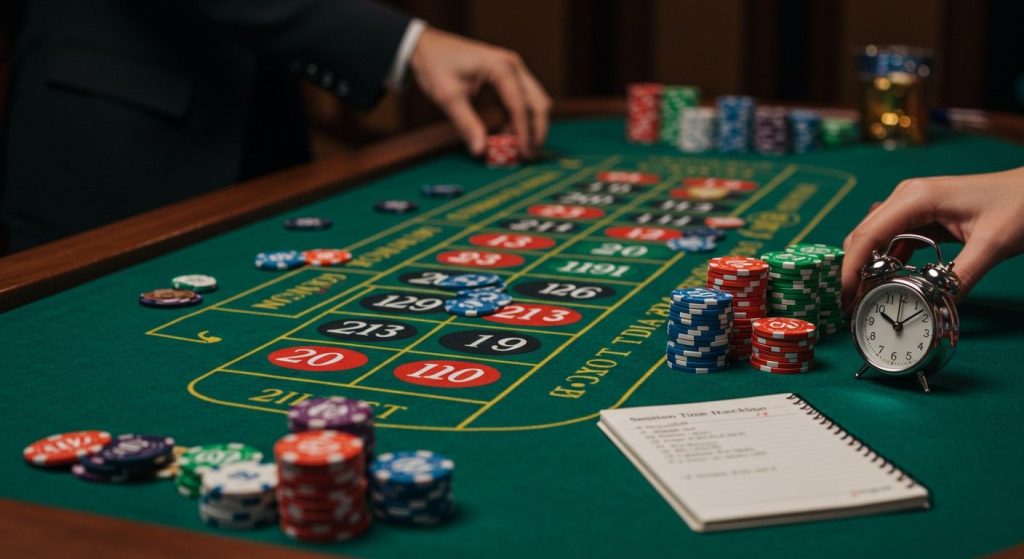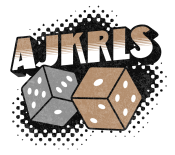by Corry, weekend gambler turned number-nerd
A personal note before we begin
I wrote this guide after years of lingering at felt tables, chasing flashing reels, and scribbling notes while pit bosses smiled politely at my little spreadsheets. Four hours has become my sweet spot. Long enough to feel immersed, short enough that fatigue and tilt do not chew through the money I worked nine-to-five to earn. Everything that follows is practical, field-tested, and wrapped around a single mission: showing you how to decide how much cash and how many chips to bring for a focused four-hour casino push.
1. Why the four-hour window matters
Most casual players drift in and out of games with no plan at all. Time evaporates among cocktails and neon, and they realize the damage only when the bankroll is gone. A four-hour cap fixes several problems in one stroke:
- Energy management – attention fades after three to five hours, especially when the air reeks of recycled smoke and the drinks flow.
- Casino pace – comps for low and mid stakes are usually logged in four-hour blocks. A neatly tracked session helps the players club desk credit you properly.
- Measurable risk – probability math needs a horizon. Four hours delivers enough rounds to smooth out noise without plunging into the statistical canyon of an all-night binge.
Think of it as a single workout for your wallet. You warm up, push hard, cool down, then live to gamble another day.
2. The math skeleton: house edge, volume, and volatility
Before we zoom in on specific games, anchor yourself in three numbers that rule every wager:
| Term | Plain-English meaning | Typical scale in a casino |
|---|---|---|
| House edge | The average slice of each bet that a casino keeps | Blackjack with basic strategy: ≈0.5 % • European roulette: 2.7 % • American roulette: 5.26 % • Modern video slots: 4 %–10 % |
| Rounds per hour | How many hands, spins, or pulls you face in sixty minutes | Blackjack: 60–80 • Roulette: 35–45 • Slots: 400+ if you rapid-fire |
| Standard deviation | How wild your results swing around the average | Low for blackjack, high for inside roulette bets, extreme for high-volatility slots |
Your expected hourly loss equals edge × bet size × rounds per hour. Volatility tells you how far actual results may drift from that average. A proper bankroll covers both the predictable leak and the sudden gusts that can push you deep into the red before luck snaps back.
3. Blackjack: the disciplined grinder’s playground

3.1 Estimating volume
On a full table you’ll see roughly 60 hands per hour. Head-to-head with the dealer that bumps beyond 100, but fatigue accelerates too. For our four-hour blueprint I assume 70 hands per hour – a realistic median.
3.2 Edge and strategy considerations
- Basic strategy drops the edge to about 0.5 % when the game offers 3:2 naturals, double after split, and at least six decks.
- If the house pays 6:5 on naturals, edge balloons past 1.5 %. Walk away.
- Counting or advantage play can flip the edge but that sits outside a casual blueprint. I stay with basic strategy numbers so no one needs secret hand signals.
3.3 Sizing the session
- Choose a base bet you enjoy. Let us say $10 per hand.
- Compute expected loss: 0.005 × $10 × 70 × 4 = $14 for the full session.
- Account for volatility. Blackjack’s standard deviation per hand sits near 1.15 units. Over N hands, deviation grows by √N, so for 280 hands we get 1.15 × √280 ≈ 19 units. At $10 each that is $190.
Round upward because cold streaks love to arrive when Friday paychecks are fresh. I allocate 25–30 units as a cushion. That places the recommended four-hour bankroll at $250–$300 for a $10 game.
Quick reference table
| Average bet | Bankroll cushion (25–30 units) | Expected loss (4h) |
|---|---|---|
| $5 | $125–$150 | $7 |
| $10 | $250–$300 | $14 |
| $25 | $625–$750 | $35 |
3.4 Stop lines
- Stop-loss: 30 units down.
- Stop-win: 40 units up.
Hitting either triggers a breather. You are free to pocket profit, switch games, or call it a night. Guardrails feel boring until they save next month’s rent.
4. Roulette: glamour with teeth
4.1 Know your wheel
- European wheel (single zero) – house edge 2.7 %.
- American wheel (double zero) – house edge 5.26 %.
If you have a choice, always lean single zero. Those extra 2.56 percentage points drain ninety-six dollars per $3,750 wagered, and over a year that difference buys a round-trip flight to Vegas.
4.2 Spin pace
Dealers average 38–40 spins per hour during standard floor traffic. Multiply by four and you face around 160 results.
4.3 Bet selection and bankroll impact
Roulette volatility swings with your bet type.
| Bet type | Payout | Standard deviation multiple (approx) |
|---|---|---|
| Even-money (red/black) | 1:1 | 1 unit |
| Columns/dozens | 2:1 | 1.7 units |
| Straight-up number | 35:1 | 5.9 units |
For illustration let us use $10 flat bets on red on a European wheel.
- Expected loss: 0.027 × $10 × 160 = $43.20 over four hours.
- Volatility: deviation per spin equals 1 unit. Over 160 spins, deviation = √160 ≈ 12.65 units → $126.50.
I settle on 15–20 units for even-money patterns. That lands between $150 and $200 for a $10 play.
Inside bettors targeting single numbers must widen the cushion dramatically. With a deviation near six units the four-hour swing sits around $960 for that same $10 chip. To keep anxiety in check I recommend 80–100 units when straight-upping, and only if the entertainment value of mayhem thrills you more than balanced odds.
4.4 Practical session kit
- Even-money strategy: $200 buy-in, bet $10 per spin, quit at +$100 or –$150.
- Mixed pattern (dozens plus an occasional straight-up): $400 buy-in, keep straight-up bets tiny so they do not dominate variance.
- Pure inside thrill ride: minimum $1000 reserve, tiny single numbers, or expect flameout in under an hour.
5. Slots: bright, loud, and brutally streaky
5.1 Understanding return to player
Modern US casinos publish theoretical payback between 88 % and 96 %. A 92 % return means an 8 % house edge. Edge alone does not tell the full tale because slots bundle enormous variance. A progressive jackpot machine can run negative for hours before one monster win lands.
5.2 Real pace of play
A casual puller can rack 400 spins per hour without auto-spin. Video slots do more if you tap frantically. With $1.50 to $3 a spin, money moves faster than any table game.
5.3 Calculating a blueprint bankroll
Take a middle ground example:
- Bet per spin: $2
- Edge: 8 %
- Spins in four hours: 400 × 4 = 1600
Predictable loss: 0.08 × $2 × 1600 = $256. That already stings, so cushion must cover peaks beyond it. Slot variance per spin can exceed 10 units relative to the mean, but jackpots muddy the math. I lean on a simpler rule: expect to bring 150–200 spins worth of cash if you want a decent shot at surviving the dry streaks.
For the $2 example that equals $300–$400. Some nights you will double up quickly. Others you will burn through the roll in half the planned window. Accept the risk or walk past the penny neon palace.
5.4 Tempo tricks that throttle losses
- Use single-line and low-denomination games early. Warm up, collect small base hits, stretch the bankroll.
- Shift to high-volatility bonuses only if ahead. Protect the original buy-in while hunting free spin rounds with house money.
- Set a timer on your phone. Every 30 minutes pause, log balance, and breathe. This single habit slices reckless overspend by double digits in my group of regulars.
6. Putting the blueprint together

6.1 The three-session wallet
My wallet leaves the hotel room organized into three separate envelopes:
- Blackjack bank – calculated in Section 3.
- Roulette bank – Section 4.
- Slots or “fun money” bank – Section 5.
Each envelope lists buy-in, stop-loss, and stop-win targets on the flap. Once one envelope is empty, that game is over for the night. No cross-borrowing. No ATM breaks.
6.2 Example day trip load-out
| Game | Unit size | Hours planned | Buy-in | Stop-loss | Stop-win |
|---|---|---|---|---|---|
| Blackjack | $10 | 2 | $300 | –$300 | +$400 |
| Roulette (even money) | $10 | 1 | $200 | –$150 | +$200 |
| Slots | $2/spin average | 1 | $300 | –$300 | +$300 or first jackpot |
Total cash carried: $800. Maximum drawdown if everything goes wrong: $750, still under the roll. Maximum theoretical loss (edge times action) sits around $70, $43, and $256 respectively, but the cushion means we will not wash out on pure volatility before quitting time.
6.3 Mental mechanics that back the numbers
- Short breaks every hour keep emotions stable. Grab water, step outside for fresh air, reset pulse.
- Record every session in a pocket notebook. Date, game, starting stack, ending stack, surprises. Data turns stories into insight.
- Celebrate wins properly. Skim at least half of any above-target profit into a sealed “walk-away” pocket. A souvenir steak dinner tastes sweeter than reinvesting every chip until variance claws the stack back.
7. Common mistakes and fast fixes
| Mistake | Symptom | Fix |
|---|---|---|
| Under-bankrolled blackjack | Shoving last $60 on hand 175 of 280 | Play $5 units or cut session to two hours |
| Chasing red after black streak | Tripling bet size without plan | Flat bet or use two-to-one progression max, never chase beyond 4 units |
| Slot marathon tilt | Hammering max bet auto-spin to recover | Stand up, switch machines only if calm, otherwise call it a night |
| Ignoring drink effect | Loose calls and side bets | Alternate alcohol with water, eat between sessions |
| Switching tables mid shoe | Abandoning favorable deck count | Commit to full shoe unless table vibe turns toxic |
8. Closing thoughts from Corry
There is romance in watching dealers flip aces, in hearing the plunk of a metal ball finding its pocket, in the swell of digital fanfare when scatter symbols align. Yet casinos thrive because probability grinds away at anyone who shows up unprepared. A four-hour framework, stitched with sober math and a touch of self-discipline, shifts you from prey to participant.
Bring a roll sized to your game and your goals. Log the outcome. Learn. Whether you chase a side income or pure entertainment, the blueprint above keeps the lights on at home while you chase lights on the strip.
Next time you slide a chip across the felt, know exactly why that chip is there, how many cousins sit behind it, and when the family heads back into your pocket. That clarity, more than any lucky charm, is the real edge we control.
Good luck, and may variance treat you kindly.
